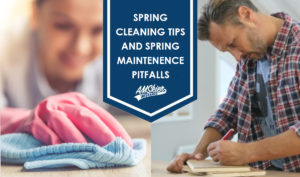
Spring Cleaning Tips and Spring Maintenance Pitfalls
Spring is here and for many of us, it’s time to begin spring cleaning projects of all kinds. No matter what is on your agenda for this spring and summer, there are a few things that should be on your checklist every year. Learn some tips to increase the longevity of your property and avoid pitfalls that typically get overlooked.
- Create a checklist.
Spring cleaning can be overwhelming. It’s important to work smarter by making a checklist, break down each room, and make sure you have the proper tools and cleaning supplies. A bathroom is going to need a different plan than your living room.
- Clear out the clutter.
One of the biggest steps of spring cleaning is to get rid of useless clutter and junk. It’s best to decide what things to keep and what to get rid of while your stuff is being moved around and searched through. To do this, divide your things into four simple categories like trash, give away/sell, storage and put away.
- Check the fridge.
It’s important to always keep your refrigerator clean and tidy. Doing so will help keep your food safe, so this should be done year-round. Salt and soda water are an effective combination to help clean any messes that might be left over. Also, make sure you clear out the coils on the back of the fridge to help keep its longevity.
- Clean all gutters.
Poor or improper drainage can cause water damage to your home. Check for loose and leaky gutters and ensure downspouts are positioned to drain away from your home’s foundation. Clear debris from all gutters and downspouts.
- Inspect the roof.
Your roof is your home’s primary defense against the elements. Visually inspect the roof, look for signs of warping, as well as cracking and loose shingle or tiles. Examine flashing around chimneys, skylights, and vents. Damaged covering and flashing should be replaced. For roof areas too high to inspect from the ground, hire a licensed roofer to perform the inspection and make necessary repairs.
- Check seals around windows and doors.
Cold weather can cause seals around windows and doors to loosen, harden and crack. Inspect these areas for damage and make repairs as needed. This will help reduce summer cooling costs and keep water out of your home.
- Service your home’s cooling system.
No one wants to be caught in the dog days of summer without air conditioning. It’s a good idea to have your home’s cooling system checked yearly, about one month prior to regular summer usage.
- Check smoke detector batteries.
This is an easy and potentially lifesaving task. Take time now to change the batteries in all your home’s smoke detectors. Better safe than sorry.
- Spring cleaning for the disposal.
When you think about everything that goes down the kitchen sink, a good yearly cleaning for the disposal is in order. Simply feed a tray of ice cubes through it while running cold water.



 PREVENT THIS:
PREVENT THIS: